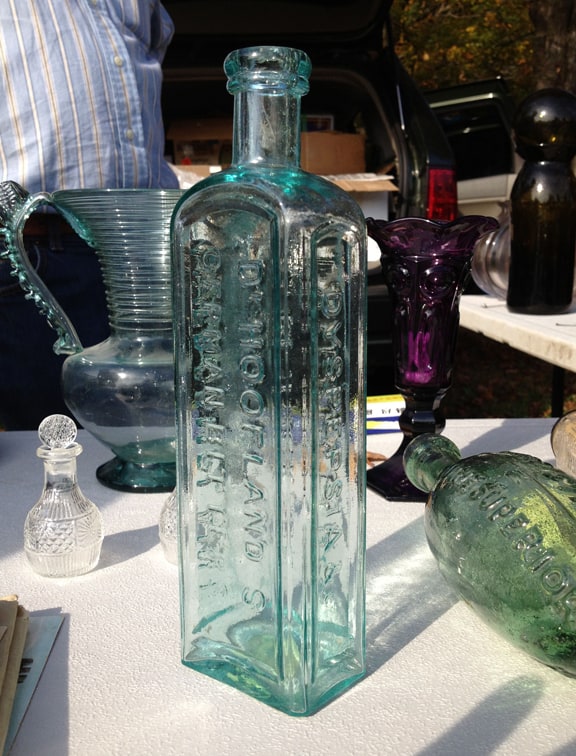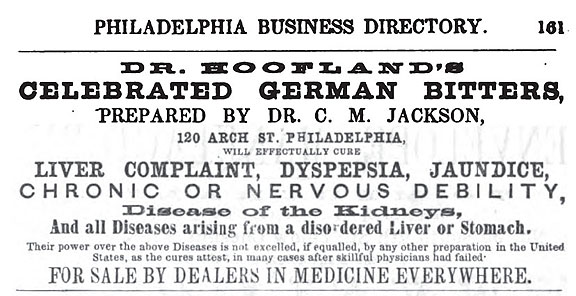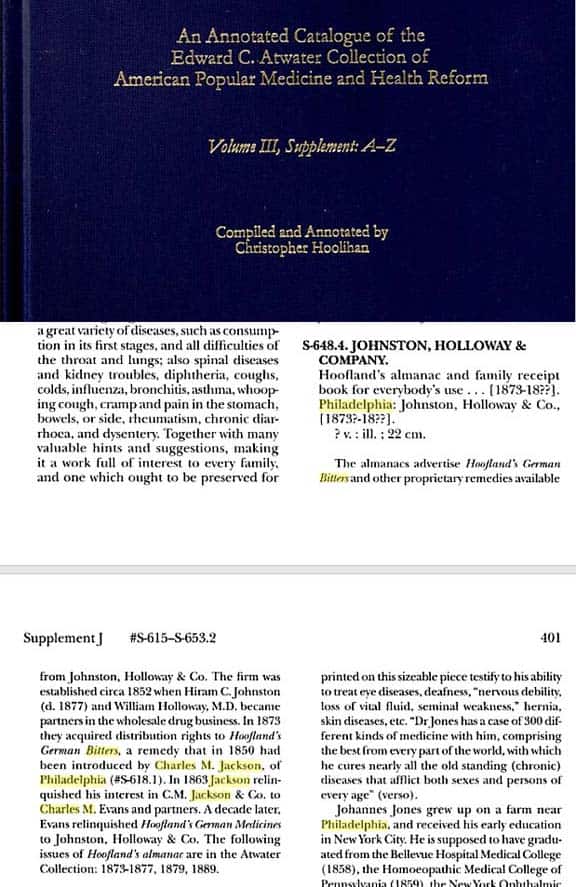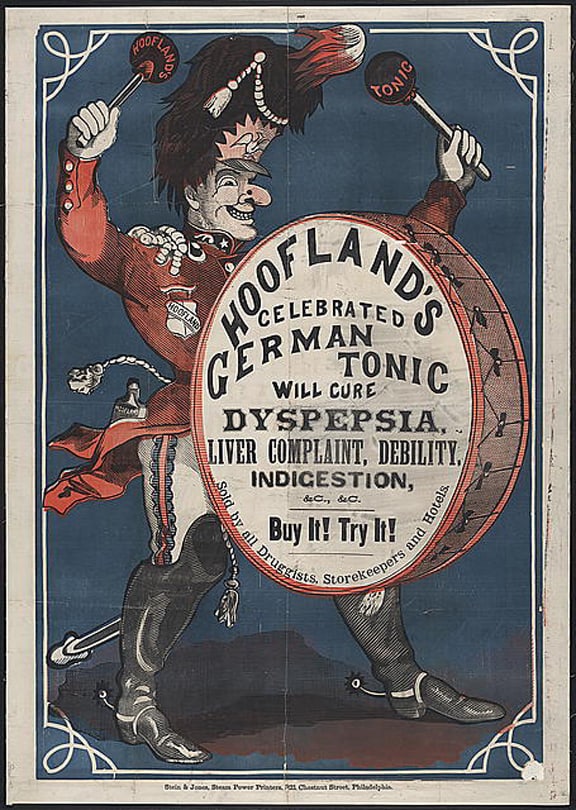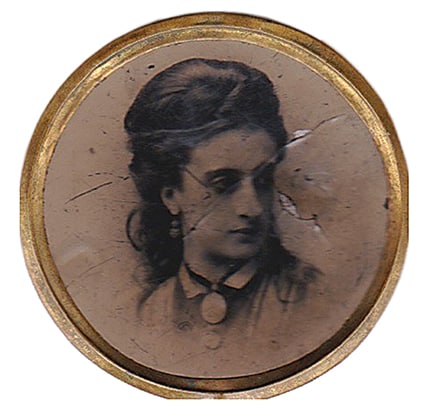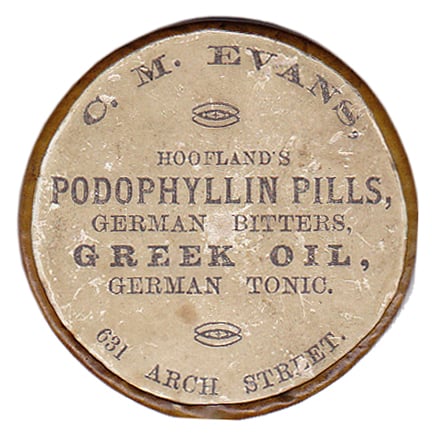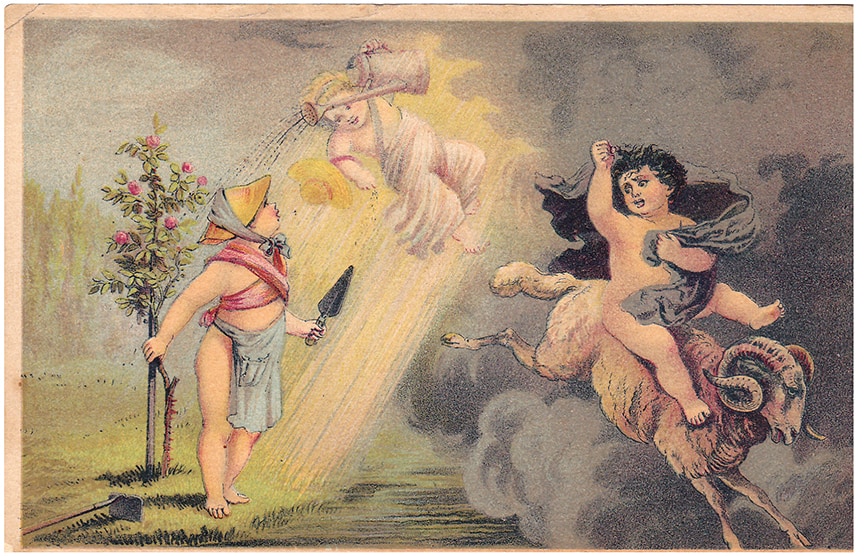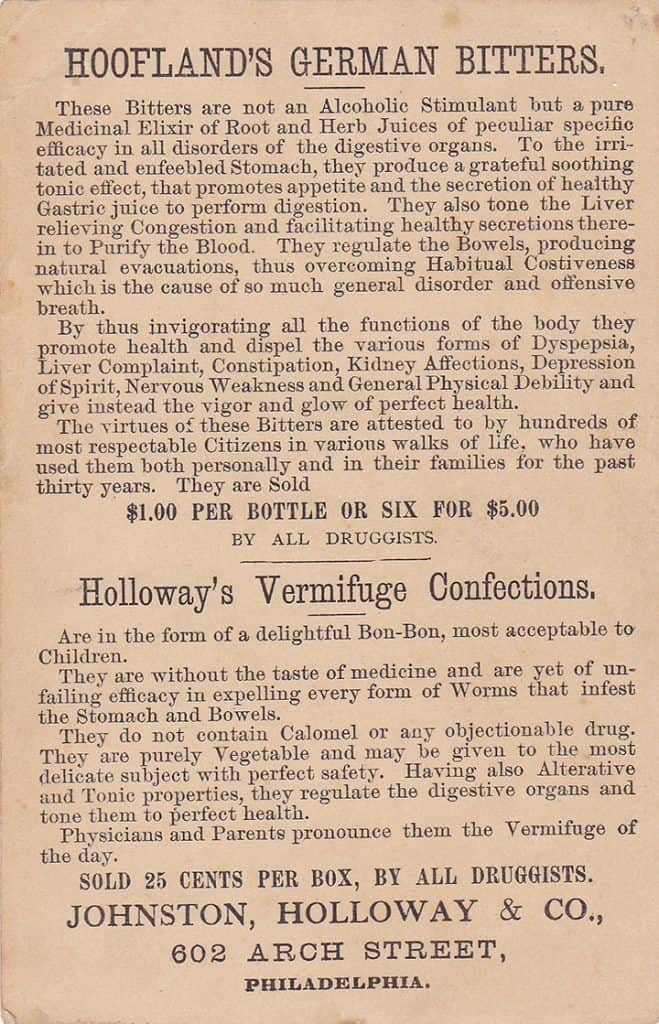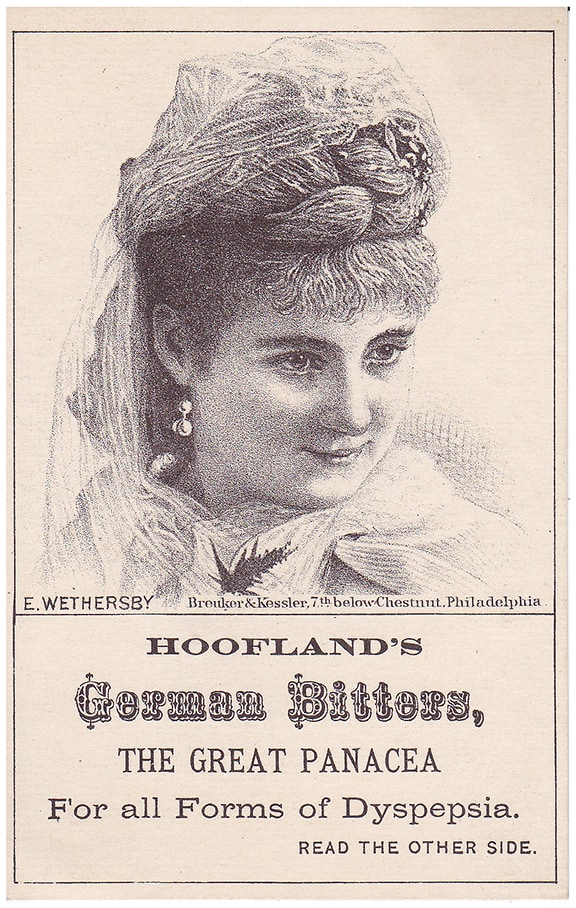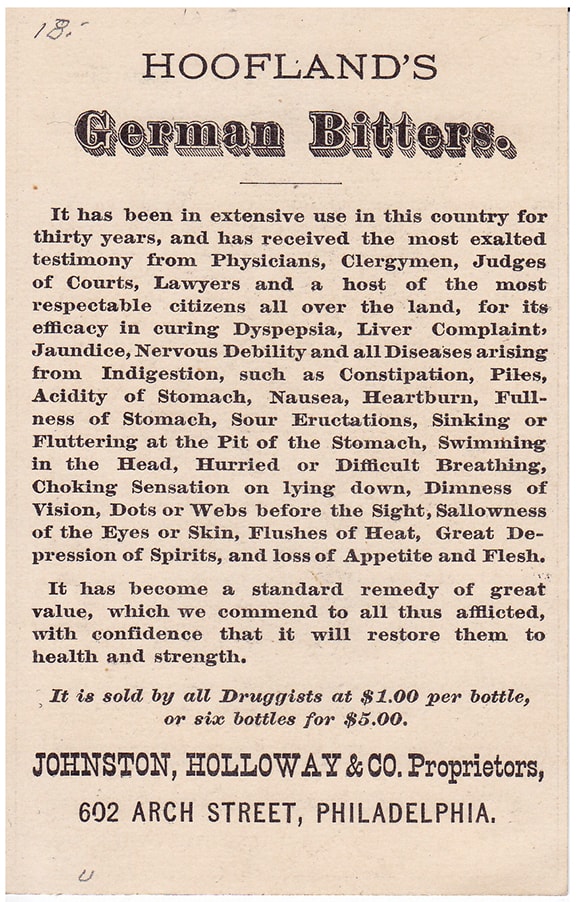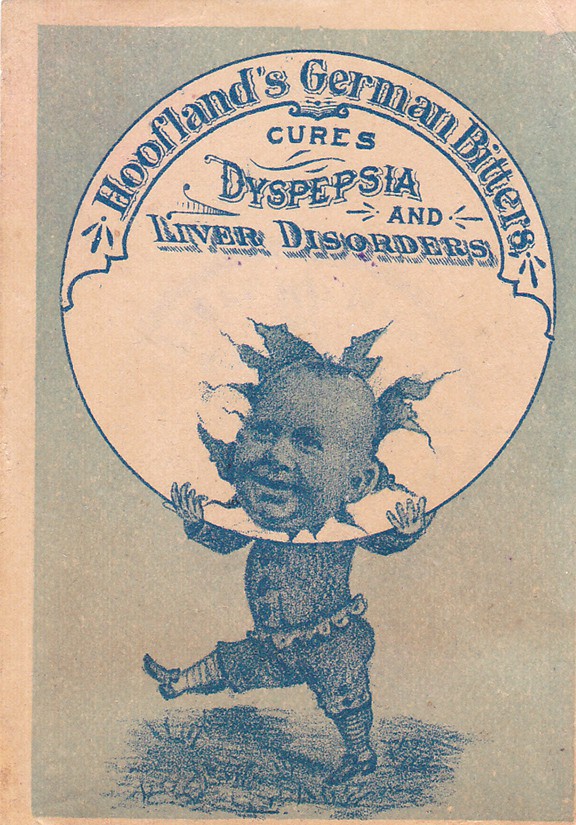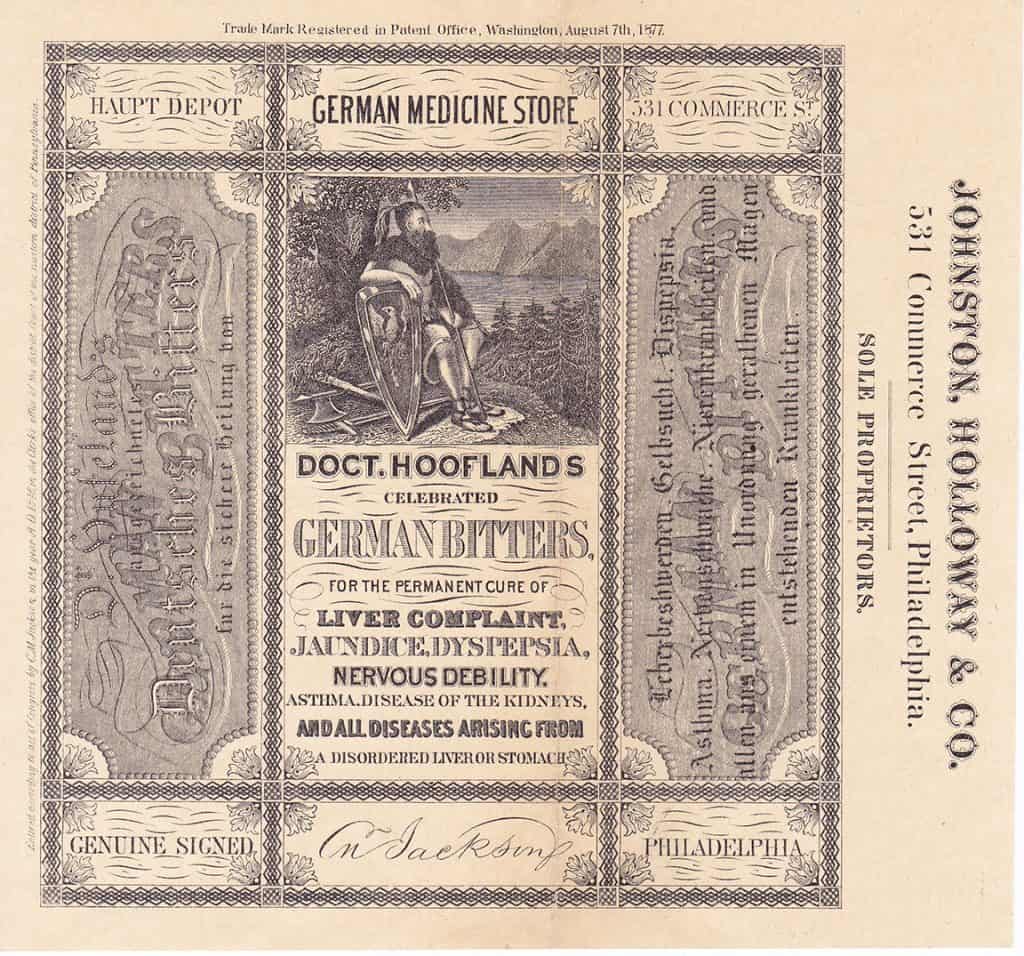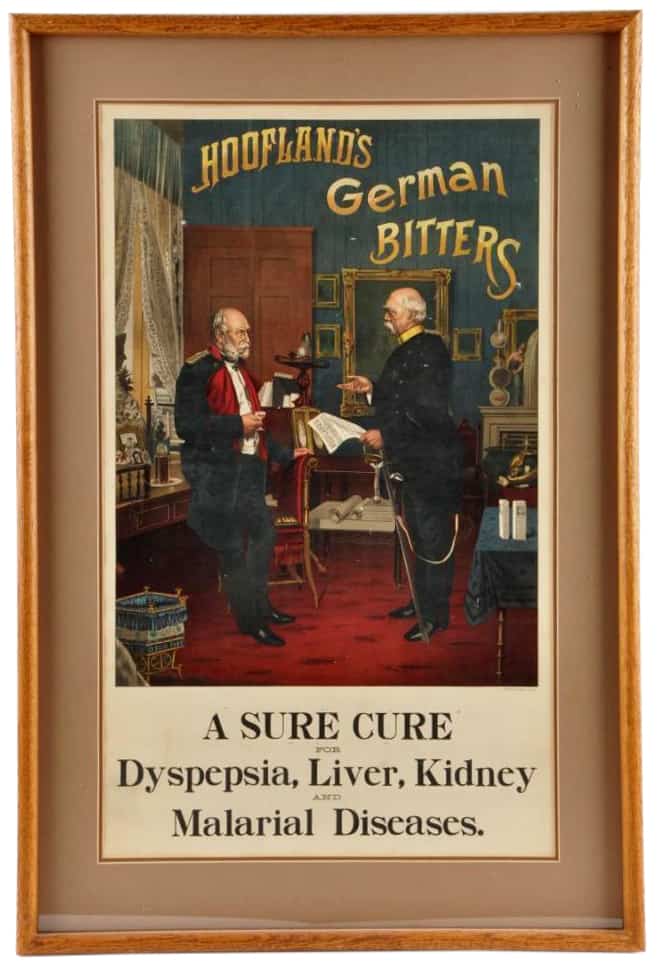A larger Dr. Hoofland’s German Bitters spotted in the Hayfield
9 October 2012 (R•090918) (R•021219)
“the happy result of intelligent research, coupled with the extensive practice of Dr. Christoph Wilhelm Hueflin of Gena, Germany.”
![]() Jan Ratushny had this large Dr. Hoofland’s Celebrated German Bitters at the Heckler hayfield event this past weekend in Woodstock Valley (pictured above), Connecticut. This is a common bottle as I have two of the smaller example bottles (see further below). I just have not seen this larger size. This prompted a search for a little more information on the brand and bottle that spanned some 40-plus years.
Jan Ratushny had this large Dr. Hoofland’s Celebrated German Bitters at the Heckler hayfield event this past weekend in Woodstock Valley (pictured above), Connecticut. This is a common bottle as I have two of the smaller example bottles (see further below). I just have not seen this larger size. This prompted a search for a little more information on the brand and bottle that spanned some 40-plus years.
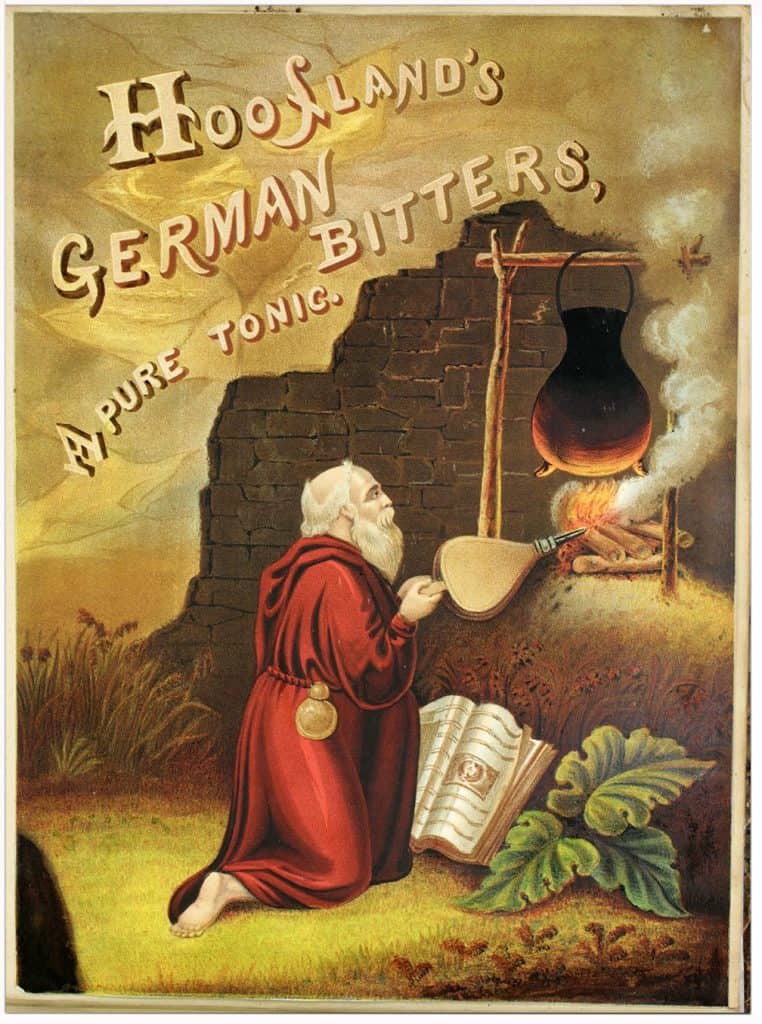
Hoofland’s German Bitters advertisement for the patent medicine showing a medieval scene. – Library Company of Philadelphia| Print Department
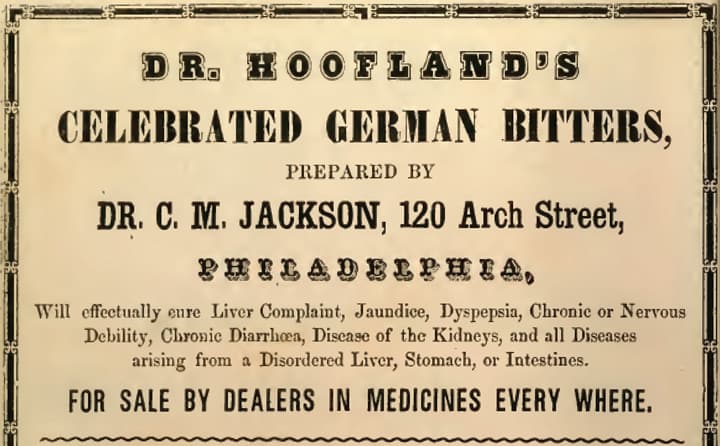
Dr. Hoofland’s Celebrated German Bitters prepared by Dr. C. M. Jackson advertisement – 1854 Philadelphia City Directory

Dr. Hoofland’s German Bitters advertisement, Jones & Evans – The Rock Island Argus, Saturday, June 13, 1863
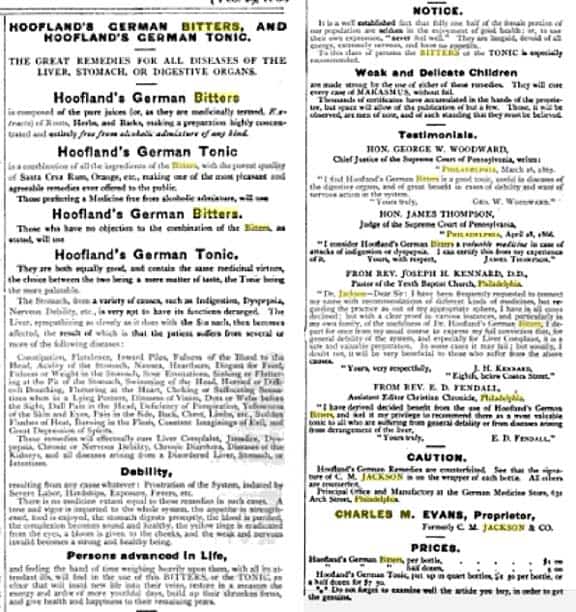
Advertisement from The Round Table – A Saturday Review of Politics, Finance, Literature & Society – 1867
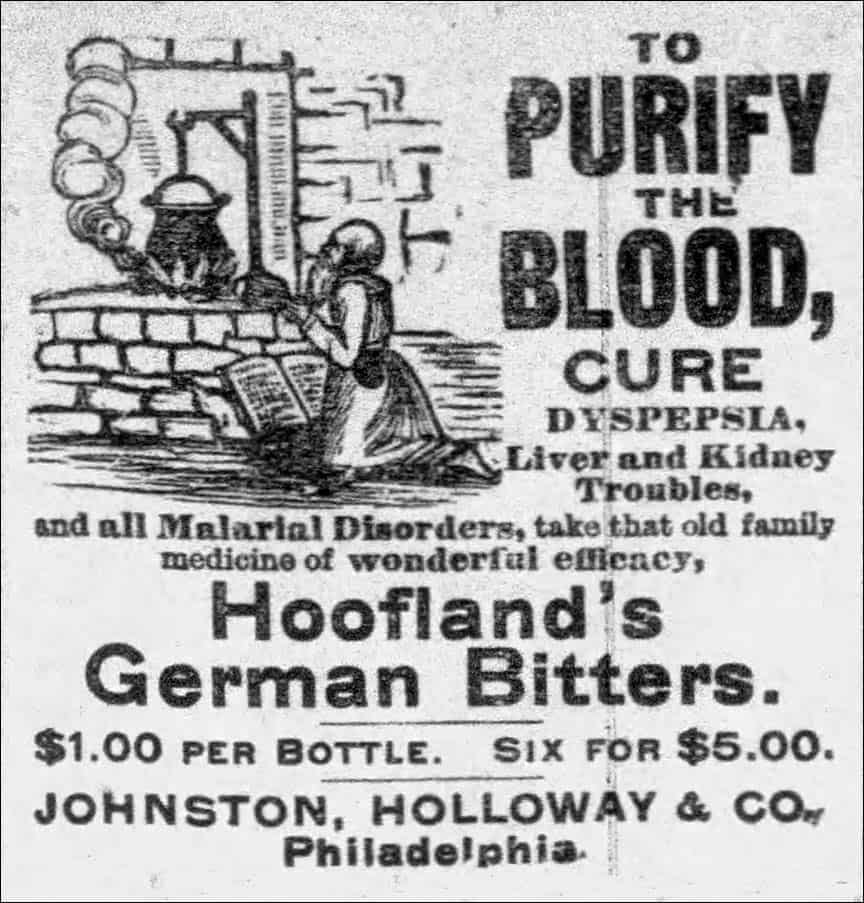
Advertisement for Hoofland’s German Bitters, Johnson, Holloway & Co. – Wilkes Barre Times Leader The Evening News, Monday, August 3 1891
First of all, the Carlyn Ring and W.C. Ham listing in Bitters Bottles is as follows:
H 168 DR. HOOFLAND’S GERMAN BITTERS
DR. HOOFLAND’S / GERMAN BITTERS // LIVER COMPLAINT // C.M. JACKSON / PHILADELPHIA // DYSPEPSIA & C //
9 1/2 x 2 5/8 x 1 3/4 (7 3/8) 1/4 Bottle 1
8 1/2 x 2 1/8 x 1 3/4 (6 3/16) 3/8 Bottle 2
7 1/8 x 2 5/8 x 1 3/4 (5 3/8) 1/4 Bottle 3
7 1/8 x 2 5/8 x 1 3/4 (5) 1/4 Bottle 4
Rectangular, Aqua, CM, Applied mouth, With and without rough pontil mark, 4 sp, Common
Bottles 1 & 3 same Dyspepsia & C
Bottle 3 Rough pontil mark
Label: A sovereign remedy for liver complaint, jaundice, dyspepsia, nervous debility, asthma, disease of the kidneys, and all diseases arising from a disordered liver or stomach. Paper seal over cork: intertwined M H G.
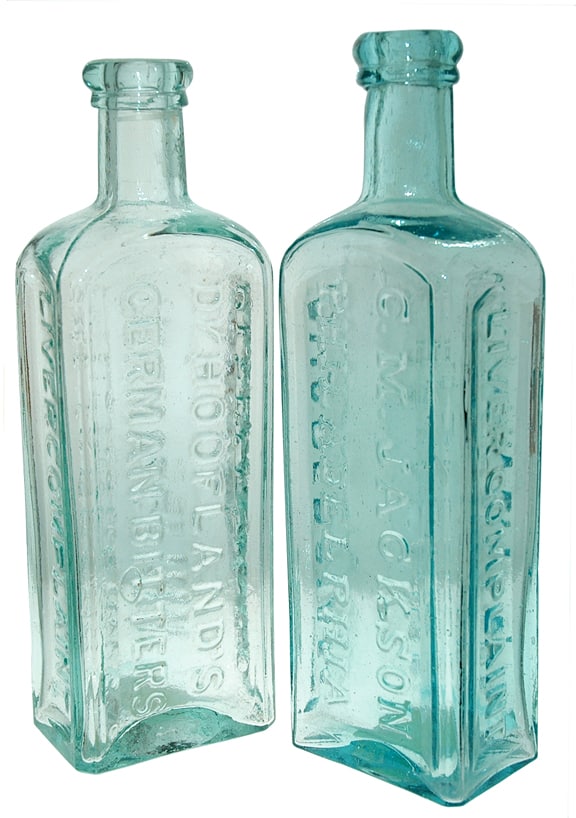
Pair of aqua DR. HOOFLAND’S GERMAN BITTERS. These are two of my first bitters bottles purchased back in 2002 – Meyer collection
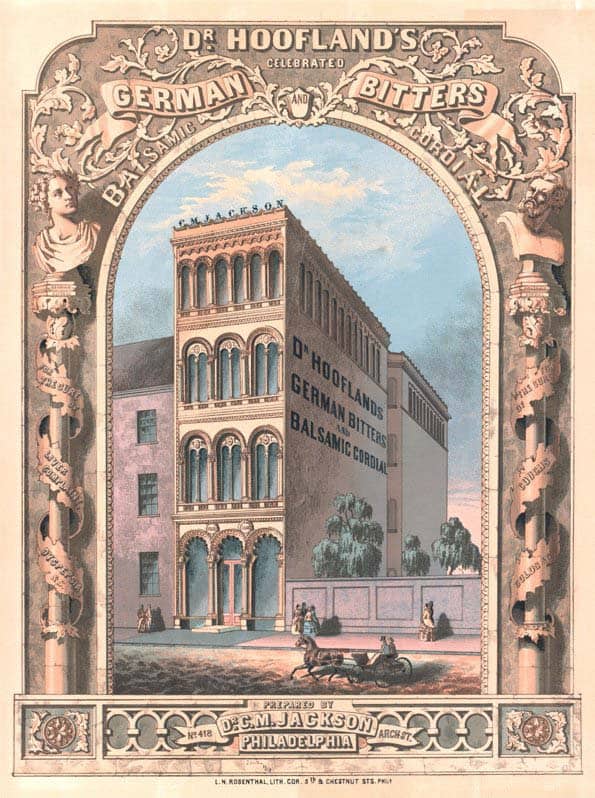
Dr. Hoofland’s Celebrated German Bitters and Balsamic Cordial, printed by Louis N. Rosenthal, January 1859 (chromolitho) – American School, (19th century) – Library Company of Philadelphia
According to Hoofland’s Almanacs, this eponymous bitters was “the happy result of intelligent research, coupled with the extensive practice of Dr. Christoph Wilhelm Hueflin (Hoofland) of Gena, Germany.” Dr. Hoofland’s Celebrated German Medicines were first being sold in Philadelphia at 278 Race Street in 1847.
The Dr. Hoofland’s Celebrated German Bitters was introduced in America in 1850 by Dr. Charles M. Jackson. Jackson was among the many 19th-century distributors peddling bitters to a receptive U.S. market.
By 1863, the product was sold to Charles Evans and R.S. Jones doing business as Jones & Evans located at 631 Arch Street in Philadelphia. You can see a newspaper advertisement further above. They were selling the bitters for 75 cents a bottle and $4 for a half-dozen. Evans had been a clerk in Dr. Jackson’s firm. By 1867, the business directories list Charles Evans as the sole proprietor of Hoofland’s German Bitters. A decade later, the proprietors of Hoofland’s German Bitters were Johnston, Holloway & Company of Philadelphia. They would sell Hoofland’s German Bitters up until 1893.
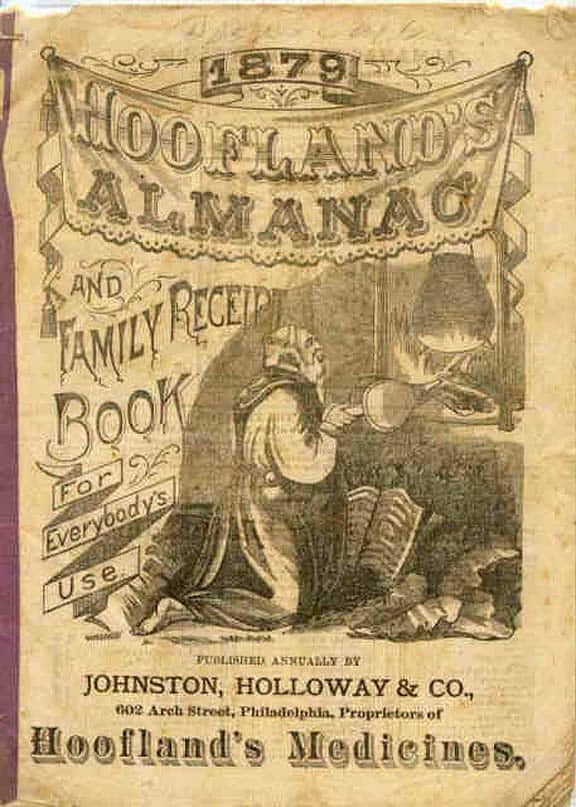
Johnston, Holloway & Co. continued to promote Dr. Hoofland’s products, as demonstrated by this 1879 issue of Hoofland’s Almanac – www.dalessandris.net
“It is for him to say whether he will continue to endure a living death or to put himself in a position to render life enjoyable.”
As noted on the embossed bottles, Hoofland’s German Bitters were marketed as a remedy for ‘Dyspepsia’ and ‘Liver Complaint.’ An advertisement proclaiming the benefits of Hoofland’s put it simply, “It is for him [the potential customer] to say whether he will continue to endure a living death or to put himself in a position to render life enjoyable.”

C.M. Evans had this essay prepared, most likely in 1866. – www.dalessandris.net
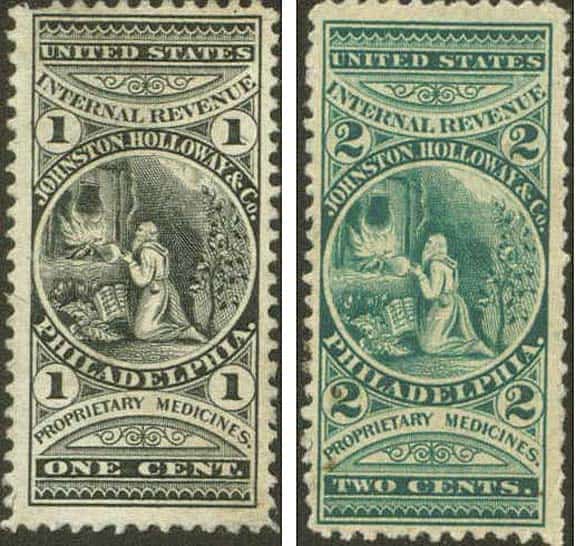
Johnson, Holloway & Co. Private Die Proprietary Stamps. Johnson, Holloway & Co. had their own private die stamps engraved in 1874. – www.dalessandris.net
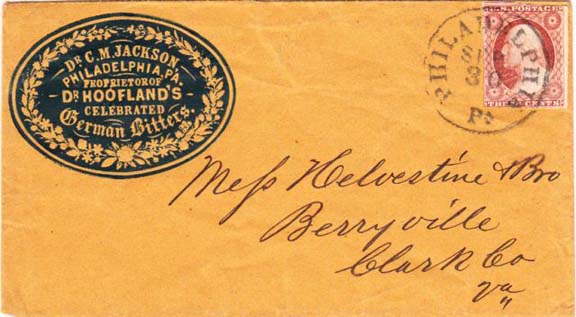
Blue cameo corner card for Dr. C.M. Jackson, Philadelphia, P.A., Proprietor of Dr. Hoofland’s German Bitters, franked with 3¢ dull red 1851, postmarked Philadelphia, September 30, circa 1851-57. This was prior to C.M. Evans’ acquisition of Jackson’s business. – www.dalessandris.net
I also found that there was a quantity of Dr. Hoofland’s German Bitters recovered from the SS Republic (see picture below), a mere 11 bottles, which pales in contrast to some of the other bitters brands found at the wreck site.
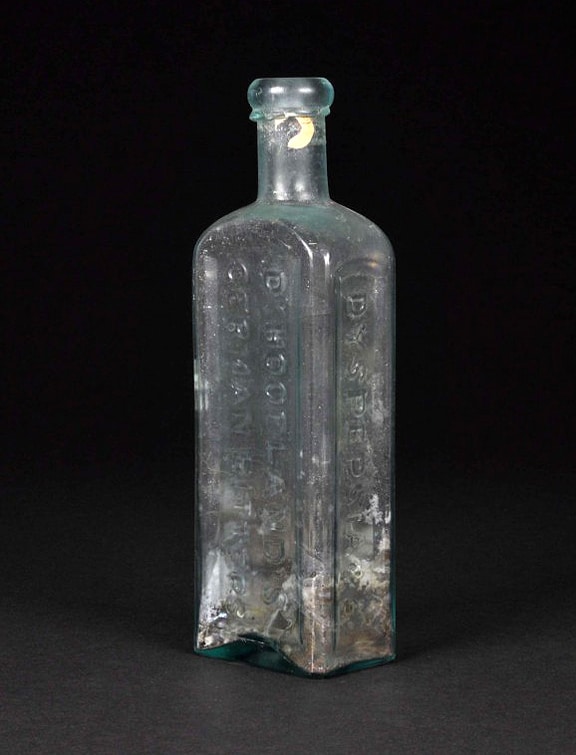
The quantity recovered from the SS Republic, a mere 11 bottles, pales in contrast to some of the other bitters brands found at the wreck site. – Odyssey’s Virtual Museum
“flavored so that the extreme bitterness of the bitters is overcome.”
There was also a Hoofland’s German Tonic which consisted of Hoofland’s German Bitters (a non-alcoholic herbal mixture) combined with Santa Cruz Rum and “flavored so that the extreme bitterness of the bitters is overcome.” It was supposed to cure dyspepsia, liver ailments and general “debility” (i.e., everything else). This information is from a 1872 ad in Potter’s American Monthly.
However, in 1887, the Chicago Medical Times published a study of tonic medicines and stated that the German Tonic was just over 29% alcohol, which may explain the look in the drummer’s eye above.
The 1872 advertisement states that it cost $1.50 a bottle, which some people thought was too expensive – but that was because everything in it was pure and of a good quality. And it was recommended by “the Whole Supreme Court of Pennsylvania,” too.
Methodist ministers approved of the alcohol-free German Bitters. In an 1862 ad, in a Methodist journal, Hoofland’s lists a number of specific symptoms the Tonic cured, including “Constant Imaginings of Evil” and “Depression of Spirits.”
From the Joe Gourd Collection
Below: Hoofland’s Podophyllin Pills, German Bitters, Greek Oil & German Tonic shell card (unknown female) obverse and reverse. C.M. Evans, 631 Arch Street. Circa 1867 – Joe Gourd Collection
Below: Hoofland’s German Bitters advertising trade card (obverse and reverse), Johnston, Holloway & Co., 602 Arch Street – Joe Gourd Collection
Below: Hoofland’s German Bitters advertising trade card (obverse and reverse), Eliza Wheathersby, Broadway actress (1845-1887), Johnston, Holloway & Co., 602 Arch Street, Philadelphia – Joe Gourd Collection
Below: Hoofland’s German Bitters Cures Dyspepsia and Liver Disorders advertising trade card (obverse, reverse blank) – Joe Gourd Collection
Below: Hoofland’s German Medicine Store wrapper (English & German) – Joe Gourd Collection
Below: Framed Hoofland’s German Bitters advertisement poster – Joe Gourd Collection

